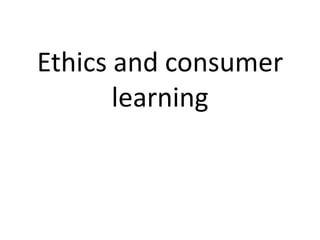Ethics and consumer learning
- 1. Ethics and consumer learning
- 2. Ethics are a collection of principles of right conduct that shape the decisions people or organizations make A Consumer Learning is the process by which individuals acquire the purchase and consumption knowledge and experience that they apply to future related behaviour.
- 3. ETHICS AND CONSUMER LEARNING ’āśBehavioral, cognitive and observational learning can sometimes lead to undesirable behavior after a person observes a particular behavior in an advertisement or commercial and develops a cognition based on the ad, which subsequently leads to undesirable behavior. ’āśIt is difficult to develop advertisements that are free of any cues that may unintentionally cause some persons to draw the wrong conclusions and engage in undesirable behavior. ’āśSince children are more likely than adults to imitate behavior they see on TV with little or no evaluative judgment, there are many ethical concerns regarding advertising to children.
- 4. ’āśAdvertising to children is subject to self-regulation according to guidelines developed by the ChildrenŌĆÖs Advertising Review Unit (CARU) of the Council of Better Business Bureaus. ’āśCurrently a major concern regarding the impact of marketing on childrenŌĆÖs behavior is whether food marketers ŌĆ£teachŌĆØ children to eat more than they should, and thus cause the surging obesity and health problems among young consumers. ’āśThe principle of stimulus generalization can also be used to confuse consumers and alter intended consumption behavior
- 6. ’āśInvolvement refers to how much time, thought, energy and other resources people devote to the purchase process. ’āśThere are three levels of involvement, high, low and no involvement. ’é¦High Involvement ’é¦Low Involvement
- 7. High involvement ’āśIt occurs when an individual perceives an expected purchase that is not only of high personal relevance but also represents a high level of perceived risk. ’āśCars, washing machines, houses and insurance polices are seen as ŌĆśbig ticketŌĆÖ items, infrequent purchases that promote a great deal of involvement. ’āśSince it involves high risk, customers devote a great deal of time to researching the intended purchase and collecting as much information as possible in order to reduce, as far as possible, levels of perceived risk.
- 8. Low Involvement ’āśIt state of mind regarding a proposed purchase suggests little threat or risk to the consumer. ’āśLow-priced items such as washing powder, baked beans and breakfast cereals are bought frequently, and past experience of the product class and the brand, cues an individual into a purchase that requires little information or support. ’āśItems such as alcoholic and soft drinks, cigarettes and chocolate are also normally seen as low involvement,
- 9. Thank you









